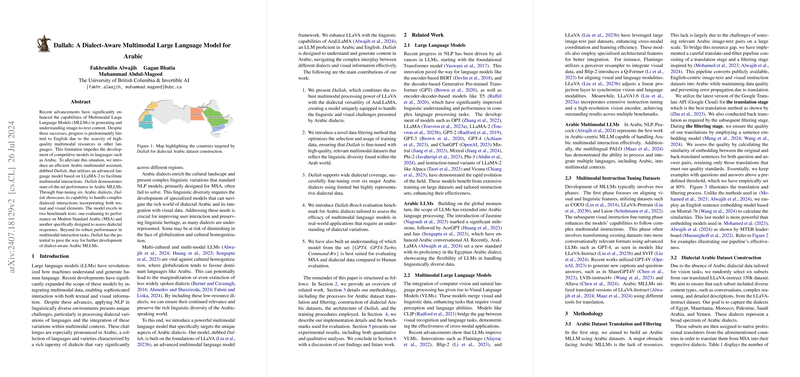Dallah: A Dialect-Aware Multimodal LLM for Arabic
The paper presents Dallah, a multimodal LLM (MLLM) specifically designed to enhance Arabic NLP by integrating dialectal variations with visual data comprehension. Built on the LLaMA-2 framework, Dallah stands as a significant endeavor in addressing the scarcity of high-quality Arabic multimodal datasets, thereby overcoming the prevalent focus on English-centric resources in existing MLLMs.
Model Architecture and Methodology
Dallah leverages the robust structure of LLaVA, a recognized framework for visual-instruction tuning, to extend its capabilities in Arabic. The model integrates a visual encoder based on CLIP-Large, bridging vision and text through a linear projection layer, while its core language processing relies on AraLLaMA—a model specifically tuned for Arabic and English. This architecture integrates the visual and textual modalities to facilitate a comprehensive understanding of linguistic nuances across six major Arabic dialects: Egyptian, Mauritanian, Moroccan, Palestinian, Saudi Arabian, and Yemeni.
A novel aspect of Dallah is the methodology employed for data preparation and training. The model's development involved an extensive translation and filtering process where high-quality, dialect-appropriate datasets were curated. This was achieved by translating existing English-centric datasets into Arabic, followed by rigorous filtering to maintain data quality—a crucial step given the diversity and nuances found in Arabic dialects. Additionally, substantial effort was placed into dialectal tuning using human-translated datasets representing the six targeted dialects.
Experimental Results and Evaluation
Dallah's performance was benchmarked using both newly created and existing test sets, such as the Arabic LLaVA-Bench for Modern Standard Arabic (MSA) and Dallah-Bench for dialectal evaluation. The model was assessed against competitors such as Peacock and PALO, both in terms of MSA comprehension and dialect-specific responses.
In MSA benchmarks, Dallah demonstrated superior performance, notably achieving higher scores across different evaluation models, including GPT-4, Cohere's Command R+, and GPT4-Turbo. The evaluations revealed Dallah's capability in complex reasoning and detail descriptions, underscoring the effectiveness of its training methodology and data preparation processes.
The model's evaluation on Dallah-Bench illuminated its nuanced understanding of dialect-specific questions, as assessed by both human and model-based evaluators. Notably, Cohere Command R+ provided evaluations closely aligned with human judgment in terms of dialect authenticity and content accuracy, suggesting its suitability for automated assessment in the context of Arabic dialects.
Implications and Future Directions
Dallah's development marks a significant progression in the field of Arabic multimodal NLP, providing a template for future development of dialect-aware MLLMs across other languages lacking comprehensive multimodal datasets. The model's ability to integrate visual cues with dialect-sensitive language processing offers substantial improvements in areas such as cultural preservation, educational technology, and human-computer interaction within Arabic-speaking communities.
Looking forward, several aspects could be further explored to enhance Dallah's capabilities. Expanding the dialectal dataset coverage and increasing the cultural representation of Arabic figures in training data could bridge identified gaps in cultural and language representation. Furthermore, addressing the model's propensity for hallucinations, especially in dialect identification and content generation, would enhance its reliability for critical applications.
Dallah's comprehensive approach to integrating and understanding dialectal variations within a multimodal framework presents substantial practical and theoretical advancements. It sets a new benchmark for future research in linguistically diverse environments, paving the way for more inclusive and culturally relevant AI systems.
